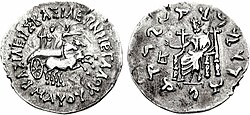Indo-Scythian dynasty
The Indo-Scythian dynasty is a kingdom that existed in northern India from the first century BC to the middle of the first century AD . The founder of the empire was Maues . The arrival of the Mau in India is unclear, but Chinese sources tell that the Saks ( Scythians ) were expelled from Central Asia and migrated south. Before the arrival of the Scythians, the region was in the hands of the Indo-Greeks , who minted coins with Greek inscriptions on the obverse and Kharoshthi inscriptions on the reverse. The coins of the Indo-Scythians usually do not show a portrait of the ruler, but a rider on the obverse. Mostly Greek deities still appear on the back.
The relationship between the Indo-Greeks and the Scythians is unclear. Previous research assumed that the Indo-Greeks were defeated and destroyed by the Scythians. However, there are also signs of coexistence, which is also supported by the fact that the Indo-Scythian coins were created based on Greek models. Some Indo-Greek rulers seem to have become vassals of the Indo-Scythians and continued to mint their own coins and were able to push them back at times.
The extent of the empire of Maues , who called itself King of Kings , can be seen from the coinage. Accordingly, he ruled in Hazara , Kashmir , Taxila and Khyber Pakhtunkhwa (northern Pakistan and parts of Afghanistan ).
Maues, the founder of the empire, died around 85 BC. The situation after his death is difficult to reconstruct. There are now various rulers in different regions who are mostly only known from their coinage. Their relationship to one another is mostly unclear. In individual cases it is often difficult to decide whether a certain ruler, who ruled over the entire empire, was a vassal, or ruler of a small independent empire. With Azes I (57–35 BC) began around 58/57 BC. A new era (calendar) and the ruler seems to have conquered large parts of northern India, including Mathura , but there were apparently still local rulers next to him. Azes II. (Approx. 35-12 BC) lost the Indus valley, but was able to conquer parts of Afghanistan. At the end of his reign there were further signs of decline, in which more vassals broke away from the empire. In the first century AD, the Indo-Scythians were slowly displaced by the Kushan and Indo-Parthians , with the latter being strongly based on the Indo-Scythians in terms of coinage and the Indo-Parthians are also often viewed as part of the Indo-Scythians.
The main rulers
Northwest India:
- Maues , approx. 90–60 BC BC coin
- Vonones , approx. 75–65 BC. BC coin
- Spalahores , approx. 75–65 BC BC coin
- Spalirises , approx. 65–57 BC BC coin
- Azes I , approx. 57-35 BC BC coin
- Azilises , approx. 57–35 BC BC coin
- Azes II. , Approx. 35-12 BC BC coin
- Zeionises , approx. 10 BC BC – 10 AD
- Kharahostes , approx. 10 BC BC – 10 AD
- Hajatria
- Liaka Kusulaka , satrap of Chuksa
- Kusulaka Patika , satrap of Chuksa and son of Liaka Kusulaka
Bajaur era (Apracharaja rulers):
- Vijayamitra (12 BC-15 AD)
- Itravasu (c. 20 AD)
- Aspavarma (15–45 AD)
Mathura era:
Minor rulers:
Individual evidence
- ↑ a b B. N. Puri, In: J. Harmatta (Ed.): History of civilizations of Central Asia , p. 193
- ^ BN Puri, In: J. Harmatta (Ed.): History of civilizations of Central Asia , p. 194
- ^ BN Puri, In: J. Harmatta (Ed.): History of civilizations of Central Asia , p. 195
- ↑ BN Puri, In: J. Harmatta (Ed.): History of civilizations of Central Asia , pp. 194-196
literature
- BN Puri: The Sakas and Indo-Parthians . In: J. Harmatta, BN Puri, GF Etemadi (Ed.): History of civilizations of Central Asia . Vol. 2 (700 BC to AD 250). Paris 1994, pp. 191-207.
- RC Senior: Indo-Scythian Dynasty . In: Ehsan Yarshater (Ed.): Encyclopædia Iranica , as of: July 20, 2005, accessed on June 5, 2011 (English, including references)
Web links
Coordinates: 28 ° N , 74 ° E

